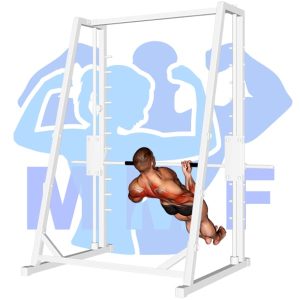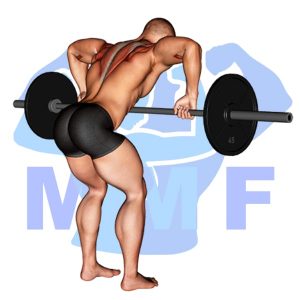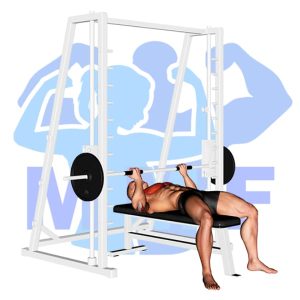Are you having trouble targeting your rear delt muscles during your workouts? Do conventional exercises just not seem to be doing the trick? If so, you’re not alone. Many people struggle to properly engage and develop their rear delts, but the solution may be simpler than you think. One common cause of this problem is not incorporating cable rope rear delt rows into your routine. But fear not, with this exercise, you can finally start seeing the results you’ve been hoping for. In this blog post, we’ll break down the proper form and technique for performing cable rope rear delt rows to help you take your workouts to the next level.
Cable Rope Rear Delt Rows Summary
- Primary Muscles: Deltoid – Posterior
- Secondary Muscles: Brachialis, Brachioradialis, Deltoid – Lateral, Infraspinatus, Latissimus Dorsi, Rhomboids, Teres Minor, Trapezius – Lower, and Trapezius – Middle
- Equipment: Cable Machine with Tricep Rope
- Mechanics Type: Compound
- Force: Pull
- Utility: Basic or Auxiliary

Cable Rope Rear Delt Rows Instructions
- Get going by setting up a rope handle on a cable row machine.
- Next sit down, brace yourself with your feet and gravel the rope handle.
- Now, pull the rope up to your chin with your back by pulling your elbows back.
- Then pause, but don’t rest in the contraction and finally, let the cable pull your arms back straight.
- This is one repetition, continue for a complete set of 8-12.
Video Tutorial
Cable Rope Rear Delt Rows Muscles
Target (Agonist)
Synergists
- Brachialis
- Brachioradialis
- Deltoid – Lateral
- Infraspinatus
- Latissimus Dorsi
- Rhomboids
- Teres Minor
- Trapezius – Lower
- Trapezius – Middle
- Wrist Flexors
Dynamic Stabilizers
Stabilizers
- Deltoid – Anterior
- Levator Scapulae
- Trapezius – Middle
- Trapezius – Upper
- Wrist Extensor
- Wrist Flexor
Antagonist Stabilizers

Benefits of Cable Rope Rear Delt Rows
The Cable Rope Rear Delt Row is an effective exercise to target the posterior deltoid muscle in a strength training or fitness routine. This exercise helps to improve posture, develop shoulder stability, and strengthen the muscles of the upper back. It also helps to increase the size and strength of the posterior deltoid muscle, which is important for shoulder health and mobility. Additionally, this exercise can help to improve shoulder joint health by increasing range of motion and flexibility. Performing Cable Rope Rear Delt Rows regularly can help to increase overall shoulder strength and stability, which can lead to improved performance in other exercises and activities.
Tips for Performing Cable Rope Rear Delt Rows
Your at the right place if you’re trying to enhance your cable rope rear delt rows performance. Using these tips will allow you to take full advantage of this amazing workout. You will develop your upper back muscles, and even reduce your risk of experiencing an injury. Let’s get begin and look at what these tips can accomplish for you.
- Start with a light weight: Before increasing the weight of the cable rope, make sure you are comfortable with the motion and can perform it without any strain or injury. This is beneficial to ensure that you are not starting off too heavy, which can lead to injury.
- Keep your back straight: Make sure to keep your back straight and your core engaged during the exercise to get the best results and avoid any strain on the lower back. This is beneficial because it will help you achieve maximum results while avoiding any potential injuries.
- Control the weight: Make sure to keep the weight under control throughout the exercise, by bringing it up and down in a slow, controlled motion. This is beneficial because it will help you get the most out of the exercise, as well as making sure you don’t put too much strain on your body.
Benefits and Tips Video
Frequent Mistakes To Avoid
When conducting cable rope rear delt rows, avoiding typical mistakes can be the difference to achieving optimal results and avoiding injury. Moreover, getting optimal results from this exercise requires appropriate technique, and avoiding perform typical errors can allow you to perform the exercise correctly and achieve optimal results. But relax, it’s not quite as difficult as it might seem. By knowing the errors to avert and taking the appropriate actions, you may complete the exercise securely and successfully. So it is time for you to optimize the impact of this exercise and enjoy the advantages of a successful workout.
- Not keeping the shoulders back and down: It is important to keep the shoulders back and down throughout the exercise to ensure proper form and to prevent strain on the shoulder joints.
- Not engaging the core: Engaging the core is necessary to stabilize the body and to maintain a neutral spine during the exercise.
- Using too much weight: Using too much weight can lead to injury and will not allow for proper form, which could lead to an ineffective exercise.
Find More Cable Exercises Here
Variations and Complementary Exercises
If you’re looking for variations, complementary, or alternative exercises for Cable Rope Rear Delt Rows, then you’re in luck! There are plenty of options available that work the same muscles as Cable Rope Rear Delt Rows. Here’s a list of some of the best:
Dumbbell Chest Supported Row

The Dumbbell Chest Supported Row is a great complementary or alternative exercise to the Cable Rope Rear Delt Row. It works both the upper and middle back, while also targeting the rear delts. To perform this exercise, begin with a dumbbell in each hand and rest your chest on an incline bench. From here, row the dumbbells up towards your chest, squeezing your shoulder blades together at the top of the movement. This exercise can be done with either a neutral or pronated grip depending on your preference. The chest supported position allows for a more isolated contraction of the back muscles, making it a great addition to any back workout.
Dumbbell Rear Deltoid Raise

The Dumbbell Rear Deltoid Raise is a great complementary or alternative exercise to Cable Rope Rear Delt Rows. This exercise works the same muscles as the cable row, but in a different way. When performing the Dumbbell Rear Deltoid Raise, you stand with your feet hip-width apart and hold two dumbbells in each hand at your sides. Keeping your arms straight, you slowly lift the dumbbells out to your sides and up to shoulder height, then lower them back down. This exercise helps to target the rear deltoid muscles while also working the shoulders, triceps, and upper back.
EZ Bar Reverse Grip Bent Over Row

The EZ Bar Reverse Grip Bent Over Row is a great alternative or complementary exercise to the Cable Rope Rear Delt Row. This exercise targets the same posterior deltoid muscles as the Cable Rope Rear Delt Row, but with a slightly different angle and range of motion. It also incorporates the use of an EZ bar, which can be more comfortable to grip and can provide more stability than the rope. The EZ Bar Reverse Grip Bent Over Row is a great way to add variety to your back workout and to target the rear delts from a slightly different angle.
Check Out These Top Cable Exercises
Inverted Row Underhand Grip

The Inverted Row Underhand Grip is a great alternative or complementary exercise to the Cable Rope Rear Delt Rows. This exercise involves using a barbell or TRX straps and pulling your body up towards the bar. The underhand grip allows for greater emphasis on the back muscles, particularly the lats, which are important for overall upper body strength. It also involves a greater range of motion than the Cable Rope Rear Delt Rows and can be adjusted to different levels of difficulty depending on the height of the bar. This exercise is perfect for building strength and stability in your back and shoulder muscles, and can be used as either a primary or supplemental exercise.
Barbell Incline Row

The Barbell Incline Row is a great alternative or complementary exercise to Cable Rope Rear Delt Rows. This exercise works the back muscles, specifically targeting the lats and rhomboids, while also engaging the biceps and core. The incline row is performed by positioning yourself on an incline bench and grasping the barbell with an overhand grip. Keeping your back straight, pull the barbell up to your chest and pause before slowly lowering it back down. This exercise is great for building strength, stability and improving posture.
Barbell Rear Delt Row

Barbell Rear Delt Rows are a great complementary or alternative exercise to Cable Rope Rear Delt Rows. This exercise targets the same muscles as Cable Rope Rear Delt Rows, but with a different range of motion. To perform this exercise, you will need a barbell and a bench. Start by positioning yourself in the bent-over position, with your chest parallel to the floor. Place the barbell on your thighs, and grip it with an overhand grip. Now, using your lats, pull the barbell up towards your chest, keeping your elbows high. Squeeze your shoulder blades together at the top of the movement for maximum contraction. Slowly lower the barbell back to the starting position and repeat for desired number of reps. Barbell Rear Delt Rows are a great way to strengthen and build your back muscles, as well as target your rear delts for improved posture and stability.
Find More Back Exercises Here
Opposing Complementary Exercises
In order to further develop your rear delts, it is important to include exercises that work the opposing muscles to Cable Rope Rear Delt Rows. This will ensure that your muscles are properly balanced and can help prevent injury. Below are a few exercises that will do just that.
Smith Machine Decline Reverse Close Grip Bench Press

The Smith Machine Decline Reverse Close Grip Bench Press and Cable Rope Rear Delt Rows are two complementary exercises that target opposing muscle groups. The Smith Machine Decline Reverse Close Grip Bench Press works the chest, triceps, and shoulders while the Cable Rope Rear Delt Rows focus on the upper and mid back muscles. By combining these two exercises, you can create a comprehensive workout that will build strength and improve overall muscular development.
Smith Machine Decline Bench Press

The Smith Machine Decline Bench Press is an effective exercise for working the chest muscles. It is a great complement to the Cable Rope Rear Delt Rows as it works the opposing muscle group. This exercise focuses on the lower chest, which can help balance out the upper chest that is worked by the Cable Rope Rear Delt Rows. It also helps to strengthen the stabilizer muscles of the shoulders and arms, which can help improve overall stability and strength.
Smith Machine Reverse Grip Press

The Smith Machine Reverse Grip Press is an excellent complimentary exercise to the Cable Rope Rear Delt Rows, as it works the opposing muscle group. This exercise is performed by standing with your feet at shoulder width apart, and holding the barbell with an overhand grip. Slowly lower the barbell to your chest, and then press it back up to the starting position. This exercise will help to build strength in the back and rear deltoids, while also working the triceps and biceps muscles. The Cable Rope Rear Delt Rows will then work to strengthen the front and side deltoids, allowing you to develop balanced shoulder strength.
Get Stronger Shoulders with Cable Rope Rear Delt Rows
If you are looking for an exercise to strengthen your shoulders, try incorporating cable rope rear delt rows into your workout routine. This exercise targets the rear deltoids, which are often neglected during typical shoulder exercises. It can help improve your posture and prevent injuries. This exercise can be easily modified to fit your fitness level and can be done at the gym or at home with proper equipment. Be sure to maintain proper form and consult a trainer if you are unsure how to perform this exercise correctly.
References: Wikipedia | ExRx.net | PubMed.gov | Comprehensive List of Back Cable Exercises




